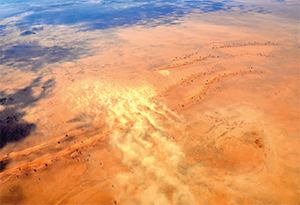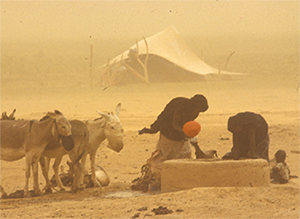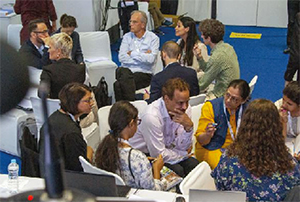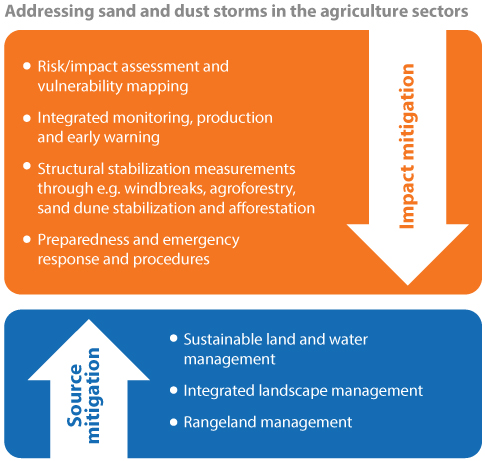Sand and Dust Storms

Sand and dust storms (SDS) have major transboundary impacts on the environment, climate, health, livelihoods, agriculture and food security and the socio-economic well-being of societies. Particularly common in arid and semi-arid regions, SDS directly affect 151 countries in Africa, Asia, North America, South America and Australia. SDS can seriously jeopardize economic development and threaten the achievement of several Sustainable Development Goals (SDGs).
Economic losses from a single SDS event can cost hundreds of millions of dollars. A major dust storm in northeast Asia in March 2021 killed 200 000 livestock and destroyed 121 animal shelters in Mongolia, caused hundreds of flights to be cancelled at airports in China and dust health advisories to be issued in South Korea. These socio-economic impacts fall disproportionately on those with least capacity to cope, including smallholders, people living in poverty and suffering from malnourishment. The frequency and intensity of dust storms have increased in some dryland regions over recent decades due to land use and land cover changes and climatic factors. Unless appropriate mitigating actions are taken, the adverse impacts of SDS will become even more severe, with many regions projected to experience increasing aridity and drought frequency/intensity due to climate change.

The agriculture sector is one of the major anthropogenic drivers of SDS – via poor land management, desertification and land degradation – but SDS also have direct impacts on agriculture, including the loss of crops, trees and livestock or significant decreases in their production.
SDS are closely linked to FAO’s work on food security and nutrition, on sustainable natural resource management, climate change and resilience. Sustainable land and water use and management practices in the cropping, livestock and forestry sectors offer strategic entry points for both SDS source and impact mitigation. Equally key are integrated landscape management, land use planning and disaster risk reduction (DRR). FAO has a strong technical focus on thematic areas that are key for SDS, such as working on desertification, land degradation and drought (DLDD) and DRR. Combating SDS assists countries in enhancing food security and strengthening resilience to risks, as well as enhancing the livelihoods and well-being of rural people. For these reasons, FAO has acted as chair of the UN Coalition on Combating Sand and Dust Storms in the period 2020-2022.
FAO has consolidated a list of existing tools that are relevant to SDS. These tools provide essential data/information to better assess the sources, dynamics and impacts of SDS. They also include tools/approaches that are useful to promote wider implementation of sustainable land resources management practices to reduce the source and/or impact of SDS. Tools primarily designed for DRR, emergency preparedness or for land use/resources planning are also useful for managing both source and impacted areas in the context of SDS risk and exposure.

Due to the frequently transboundary scale of SDS and in line with the UN Coalition’s strategy, FAO has initiated an interregional work programme for “Catalysing investments and actions to enhance resilience against sand and dust storms in agriculture”. This technical cooperation programme aims to strengthen evidence-based understanding of SDS and their impacts on agriculture, and to identify context-specific, high-impact strategies and interventions to enhance the resilience of agriculture-dependent communities to SDS.
FAO’s work on SDS is cross cutting and linked to several other units/offices including the Land and Water Division, the Office of Emergencies and Resilience, and the Regional Offices for the Near East and North Africa, Asia and the Pacific, and Africa.

